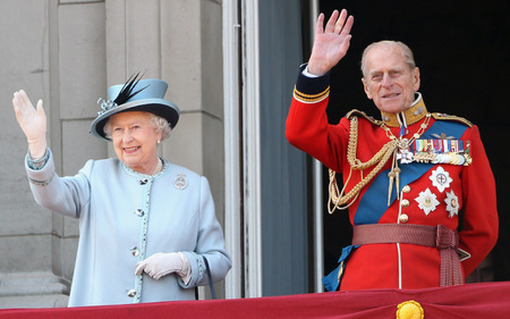 HM The Queen and The Duke of Edinburgh. By:
Thomas J. Muscatello-DeLacroix Mills
Secretary General, the British Monarchist League
It is well known that Republic dislikes, disrespects and would like to dismantle the monarchy piece by piece. However, what Republic does not see, nor do they want to understand is not just the value of the monarchy, but the personification of the State in Her Majesty The Queen, the binding and unifying factors of the institution of the Crown, and the culmination of our heritage, culture, and traditions in a viable and treasured Head of State whom is living history herself. The benefits of the British Crown and the return to the population, far outweigh the true cost of the crown to the public. Republic has recently released their version of what they feel is a true and accurate cost of the Crown to the public; however, despite their exaggeration and need to paint the monarchy black, their press release and figures actually raise more questions, which dispel Republics claims by acknowledging the real facts about the true cost of the monarchy.
Republic’s new accounting of Crown finances raises a lot more questions than it answers, and further goes to show that Republic is a biased organisation which uses flawed and false information, along with skewed facts to further their destructive agenda. If Republics findings and accounting is truly accurate, then why are the following questions left unanswered, and not acknowledged by the Republic organisation?
1) In recent years, more news articles have stated that the cost of Royal security is estimated at around £50M, including at least one article that gives mention to this figure in 2011. If this is truly the cost (which everyone has accepted), why does republic all of a sudden decide to pick one solitary figure, when previously they have estimated the cost between £50-£100 million? If we take the high figure of £100M to protect and secure the Queen and the royal family, then how much does republic think it would cost to protect an elected President and their family if Britain was to become a Republic? Royal palaces and castles (or Presidential compounds) would still need protection, as would the people in power and their family members who would live in them.
2) If Republic feels that the cost of securing a “First Family” would be far less in a republic than securing the royal family in our constitutional monarchy, is Republic stating that there would be a need for fewer protection/security officers? If this is the case, Republic is acknowledging that employed individuals would be made redundant (which would then force them to seek temporary council assistance or unemployment assistance), or transferred to other duties which would mean the cost of them being employed (or on subsidy) would remain the same or possibly higher, so in retrospect this statement of Republic’s reporting cannot be deemed an actual "savings" to the tax payer.
3) Republic should be able to explain fully, with hard facts and costs, as to why a “Republic” would cost less to the taxpayer. Does Republic prove that a President would be a less high profile target than the Queen? If in fact a President of the United Kingdom would be less of a Target than the Queen, does Republic accept that a Ceremonial President would be of far less interest to the people of this country and the world than the Queen and Royal Family, due to their international celebrity status as well as international role as the Head of State and royal family of 16 other nations?
- Would the cost to the taxpayer be less because a Ceremonial British President would not be the Head of State of the addition 15 other Nations in which the Queen is currently the Head of State? Does that difference not make it an unfair comparison, which can be seen as to why we have to pay to protect foreign heads of state if they visit the United Kingdom, and also when the Queen travels abroad to those nations where there is a requirement for additional protect? Republic often likes to pretend that the crown is not the head of other nations, nor do they give reference to the Commonwealth, in which they treat these facts as if they do not exist. Republic therefore refuses to acknowledge the role of the crown in respect to its position as Head of State of other nations along with its role within the nations that comprise the Commonwealth.
- Would the cost be less according to Republic because at present, the Royal Family carries out engagements on behalf of the Queen, which are things a ceremonial president would do? Therefore at the moment the nation is getting far more in terms of service to our people than we would in a Republic with a President as currently there are over 2000 engagements carried out by the Royal family each year, as compared to only several hundred by the President of Ireland, and also by the President of the United States of America.
4) Republic gives mention to the cost of councils for Royal visits. Why has the estimated cost to all councils according to Republic, gone from £10 million to £26 million, when the sourcing does not suggest any new information? If a “President” was to visit councils, would the cost for his position visiting the people, be less than that of Her Majesty? How can it be reasonable and factual to take an extreme case of excessive spending by a local council (which got a lot of media attention including an article and reporting by the BBC website), and then multiply that figure by the number of engagements carried out by the Queen?
5) Can Republic be 100% sure that the Duchies of Lancaster and Cornwall will transfer into public ownership if the United Kingdom were to become a Republic? This is something Republic may want, but our constitutional history and legal system is a lot more complex than that. Taking into account the original statues of the Civil List, the transfer of ownership of any properties, buildings originally purchased with private monies of the crown (Sandringham, Balmoral, and even Buckingham House [Palace]), and the sorting out of what would truly be government property versus property owned by the royal family, would be a lengthy process indeed. By assuming all properties into public ownership as Republic are suggesting, would be unfair and almost tyrannical not to give concern to the private property of the royal family, thus making the United Kingdom no better as a Republic than what Greece currently is with the treatment of their royal family.
6) According to Republic, do the listed cost of other republics and constitutional monarchies include every cost associated that Republic has assigned to their claimed cost of our own monarchy, such as security and costs of local visits?
7) Republic claims a total expense of £15 million for the cost of maintaining the Royal palaces and Windsor Castle. These properties would still have to be maintained in a Republic unless sold off into the private sector. Does the cost of the German, Irish, or American Presidency include maintaining such significant buildings? Buckingham palace and Windsor castle are lot larger than the Irish presidential palace and that of the White House in America.
8) Republic quite often forgets that the crown holds tracts of land in its own right, which helps make up the exchange in the civil list. The entire profit from the Crown Estate (not to be confused with the crowns duchies) goes directly into the treasury for public use, in which the public are given over an extra £200M of revenue to use. The new Sovereign Support Grant which is set to replace the Civil List is based off of the profits and performance of the Crown Estate which will go to help fund the duties of the crown, which will create less of a burden on the tax payer directly. This change in how the crown is funded will show that the public is not directly paying for the crown to function, therefore relieving the tax payer from any real cost associated with financing the crown, which is currently offset by public funds. It can therefore be seen that each tax payer in the United Kingdom would then benefit directly from the new Sovereign Support Grant in the way that the crown will be funded by monies given to the treasury for public use, which they would not otherwise have if the Crown Estate or crown itself was not in existence. Therefore, the tax payer is getting more value for money within the system of our Constitutional Monarchy, as the public is in sense receiving a reduction in their taxes by an amount worth over £200M.
Given Republic’s accounting of royal finances, their report leaves more questions than it gives answers. Despite what Republic wishes to see for the United Kingdom, the truth of the matter is that things are not as cut and dry as Republic would have them be, without stripping the royal family of its dignity and the nation of its most treasured and valuable institution. By instituting a republic as the Republic organisation fancies; simply saying that the State would take everything is extremely short sighted and somewhat tyrannical which would never happen, unless through the means of a violent revolution in which Republic would not be too far removed from supporting such a process.
Royal finances are accounted for and verified though government audit so that the cost of the crown is accurate and complete. In Republics efforts to defile and discredit Her Majesty, they have inflated royal expenses, exaggerated costs, and boldly lied about the true elements of royal finance in their own “Royal Finance Report”. Her Majesty is naturally frugal and has always been accountable to the public whom she has served without a blemish for almost 60 years. Her Majesty has made the crown more transparent and cost effective over the past 20 years, and provides the nation with more value for money than any other governmental institution going.
Republic deplores the crown and even more Her Majesty, which is grossly unfair given the scandal, misuse and waste of money offered by Westminster, yet Republic does nothing to curb the expenditure or defile Downing Street or the MP’s in the ways they do Her Majesty, who has done nothing to deserve the insults and criticisms Republic offer her. Republics resentment, anger and outright lies towards the crown are reflected throughout their recent reporting of royal finances, which is a tool of deception used to mislead the public, gain sympathy for their cause, and advance their own dangerous and anarchical agenda throughout our great nation. Republics deceit will be truly uncovered early next week, as the Palace is set to report on royal finance and expenditure, where we will see the true cost of the crown to the tax payer.
BML Founder and Chairman, James Edgecombe has refuted Republic's misleading claims in today's Daily Express. '' Defenders of the monarchy dismissed claims that the amount is five times more than that calculated by Buckingham Palace.And they said that the Royal Family “is worth every penny” and accused the group Republic, which released the report, of exaggerating the costs.'' The full article can be read here: http://www.express.co.uk/posts/view/254625/-202m-Monarchy-worth-every-penny
Part One In A Series of Essays
By:
Thomas J. Muscatello-DeLacroix Mills
Secretary General, the British Monarchist League
To the outside world, Britain has long been identified by its cultural heritage along with the royal events that symbolise and exemplify the power and majesty of Britain’s people as represented by the crown. Unlike most republics that have a national day of celebration such as France (Bastille Day) and America (Independence Day), Britain has many different occasions that bring our people together in times of celebration such as Coronations, Royal Weddings, and milestone occasions worthy of national celebration. Despite the infrequent and sometimes lengthy time that passes between such celebratory occasions, there are several Royal events that are held on an annual basis within the Royal calendar, that act as national days of unity and celebration here at home. Whilst there are several events during the royal “season” each year, Britons from all regions of our glorious union can partake in a wide array of historically important and culturally pertinent events, in which we are able to gather and celebrate what it means to be British several times a year, and not just on one calendar day like in so many other nations. As the London “Royal” season enters its height during the month of June (with the most royal events taking place in such a small amount of time), three defining royal events that are held annually (The Beating Retreat, Trooping the Colour, and the Garter Ceremony and Procession), are perfect opportunities to explore the meaning behind what it means to be symbolically, as well as traditionally British. In this three part essay series, each aforementioned royal event will be explored in great detail to bring together what it means to be identified by such events, the symbolism behind the events, and what these events mean in, and to a modern Britain. As long as we have been bound by our glorious union, and even before, Britain has always been known to have a unique blend of the past with the present by intertwining the best of our cultural traditions and heritage whilst moving forward with the modern times. Even today we have a defining way of life (unlike most of our European counterparts) that bows to our culturally rich heritage while progressing in a rapidly changing and modern global community, and it is this anchor to who we are, that keeps us grounded and firmly identified as a people in an ever increasing generic union of homogenous nations. Two of our most defining royal events, Trooping the Colour and the Beating Retreat, are two ceremonies that illustrate the discipline and traditions that have made the Guards Division of the British Army one of the most respected military divisions in the world, for as long as they have served and protected their sovereign. In the past, the unique events were a routine practise that ensured the efficiency and control of large bodies of men in an era when the modern conveniences of such technologies as mobile communications were not yet developed. Though these ceremonies may appear to have no place in our modern army, they serve as a useful reminder to Guardsmen everywhere that they belong to an elite division with a distinguished record that extends across many centuries. The Beating Retreat Each year on the second Wednesday and Thursday of June (directly before the second Saturday of the month which is Trooping the Colour), the Beating retreat takes place in the heart of London on Horse Guards Parade. Not only is the Beating Retreat of historical importance, but so is the venue of Horse Guards Parade which sets the stage for both the Beating Retreat and Trooping the Colour respectively. Horse Guards Parade is a large parade ground off Whitehall in central London which was formerly the site of the Palace of Whitehall's tiltyard, where tournaments were held in the time of Henry VIII. The venue was also the scene of annual birthday celebrations of Queen Elizabeth I. The area has been used for a variety of reviews, parades and other ceremonies since the 17th century, but in more recent times Horse Guards was the Headquarters of the British Army, and also where The Duke of Wellington was based when he was Commander-in-Chief of the British Army. The current General Officer Commanding the London District still occupies the same office and uses the same desk. The Duke of Wellington also had living quarters within the building, which today are used as offices. The parade ground itself is open on the west side, where it faces Horse Guards Road and St. James's Park. It is flanked on the north by the Old Admiralty and the Admiralty Citadel, on the east by William Kent's Horse Guards — formerly the headquarters of the British Army — and on the south by the Foreign & Commonwealth Office and the rear garden wall of 10 Downing Street, the official residence of the Prime Minister. On this historically and culturally important venue, the Beating Retreat is given added prestige to its yearly ceremony on Horse Guards Parade. With the colourfully illuminated backdrop of the surrounding buildings, the parade grounds provide a sight unparalleled in beauty and history to an evening of British pomp and pageantry that is unmatched by any other. The Beating Retreat itself is a military ceremony dating back to 16th century England, when it was used as a signal to recall troops to barracks at the end of the day. With great explanation of the Beating Retreat by WG Cubbitt CBE, Major General Commanding the Household Division, during campaigns it was often difficult to gather troops together after a day’s fighting. Beating Retreat provided a signal to regroup, enabling a unit to be led as a single body to a safe encampment. Originally it was known as “Watch Setting”, and was initiated at sunset by the firing of a single round from the evening gun. Beating Retreat is similar to another British Army end-of-the day ceremony dating from the 17th century. The term appears to have been coined when the British Army was fighting in Belgium and the Netherlands. The order was “Ye Retrette to beatre att nine att night and take it from ye guard”. In an order from the army of King James II ( James VII of Scotland) which was dated to 18 June 1690, saw his drums beating an order for his troops to retreat and a later order, from William III in 1694 read, "The Drum Major and Drummers of the Regiment which gives a Captain of the Main Guard are to beat the Retreat through the large street, or as may be ordered. They are to be answered by all the Drummers of the guards, and by four Drummers of each Regiment in their respective Quarters". By 1727, Beating Retreat was a standard practise in the British Army. The order was described as follows: “Half an hour before the setting of the sun, the Drummers and Port-Guards are to go upon the ramparts and Beat Retreat to give notice to those without that the gates are to be shut. The Drummers will not take more than quarter of an hour to Beat Retreat.” Drummers from the garrison were sent out into the towns at 21:30 each evening to inform the soldiers that it was time to return to barracks. The process was also referred to as “Doe den tap toe” because it encouraged inn keepers to turn off their ale taps and send soldiers home for the night. Drummers would continue to play until curfew was sounded at 22:00. As the nature of battle changed, the need to Beat or Sound Retreat in the traditional way lessened and the practise became more of a military spectacle than an operational necessity. Traditionally, the practise of Beating Retreat also included the playing of first post by a bugler, a routine bugle call denoting the positioning of sentries. Although the first post is no longer sounded, the posting of sentries each night when on active duty is something that today remains of paramount military importance. The current version of the Beating Retreat performed yearly on Horse Guards Parade represents the 18th century Beating Retreat. It denotes the end of the working day and heralds mounting of the Guard for the night. The ceremony itself evokes a sense of tradition, pride, and ceremony that marks a continuing excellence of standards established many generations ago. Since the 1990’s the Beating Retreat has taken place on Horse Guards Parade, and for the first time ever, a foreign band was allowed to play at the Beating Retreat on 5 June, 2008. This honoured band was that of the 1st Battalion Royal Malay Regiment, who had been helping to guard London, by mounting guards at the palaces. Amongst their performance pieces were arrangements of number of well known pieces from stage and film. Since then, each year a different band is typically invited to share the parade grounds to show off their skills in marching and playing order alongside our own British Divisions. The Beating Retreat is performed by several military bands included the Massed bands of the Foot Guards, and the Mounted Bands of the Household Cavalry, as well as other performances which change each year. In 2008, the other performances were made by the Band of the Royal Malay Regiment, the Pipes and Drums of the Scots Guards, and the mounted Fanfare Trumpets and Timpani Drummers. Each year, the Massed Bands perform some ceremonial form of the retreat and it is often used as a proving test for new band members as well as a practice for difficult drill moves such as the Spin Wheel. The ceremonies generally involve the marching of the bands, the firing of cannons and other decorative presentations. This years’ Beating Retreat included the United States Europe Army Band and Chorus which was a first for Horse Guards Parade. At precisely 21:00 on Thursday 9 June, 2011, the Beating Retreat commenced with the arrival of H.R.H. Prince Philip, Duke of Edinburgh. The evening before, the Beating Retreat took place in the presence of His Excellency Louis B. Susman, United States Ambassador to London. This year’s ceremony (which is open to all members of the public) was executed by Her Majesty’s Mounted Bands, Trumpeters, Massed Bands, Corps of Drums, and Pipes and Drums of the Household Division, along with the United States Army Europe Band. As the Duke of Edinburgh processed to the covered dais to the sounds of the Warning Fanfare to take the royal salute, the cool breeze moved the trees of St. James’s park ever so gently as the sun began descending behind the heavy clouds of the night time sky. As the Royal Salute was taken and our National Anthem “God Save The Queen” sounded, the stage was set for an evening of unmatched pomp and pageantry which simply cannot be replicated anywhere else in the world. The evening started out in special sentiment, knowing that H.R.H. The Duke of Edinburgh would be celebrating his landmark 90th Birthday the next day. The music started in faint manner as the entrance of the Mounted bands commenced. As they drew nearer and nearer, eventually onto the Parade and in sight of the anxious crowd, the lights seemed to intensify in bold patriotic colours, illuminating the Admiralty and Horse Guards buildings as well as the Guard Memorial itself. The music started to grow bold and ever so loud, as the Massed Mounted bands and Trumpeters of the Household Cavalry gave way to the Musical Drive of the King’s Troop, Royal Horse Artillery. The commentary provided by Colonel Alasdair Hutton ODE TD, quickened the pace as the King’s Troop quickened pace to set their cannons and prepared to fire. The musical choices of the Royal Artillery Slow March (Attributed to H.R.H. The Duchess of Kent) and Bonnie Dundee provided a musical interlude not soon to be forgotten. Instantaneously the music began to crescendo, and the Colonel’s voice peaked as one by one the cannons sounded. The sound of the guns along with the drowned sounds of the military music created and eerie feeling to accompany the sight of illuminated smoke, and the smell of a symbolic battle that had just begun. Rounding out their highly energetic and aggressive programme, the King’s Troop, Royal Horse Artillery had departed just as fast as they had arrived similar to ghost riders in the night, having appeared and faded away as apparitions while leaving the Massed Bands of the Household Cavalry and the Corps of Drums in the lingering smog of the cannons fire. Before one could realise how much time had passed during this exciting and addictive event of phenomenal musical and military spectacle, the sounds of the Post Horn Gallop (Koenig) and Grandioso (Seitz) were fading away to the musical enjoyment of not only The Drum Major General (Crisford), and Drummers of the Queen (Hall), but a plethora of many other pieces before the venue seemed to change from the traditional British marches and military drills of our own beloved guard to a highly paced and lighter feel of the United States Army Europe Band and Chorus. Entering the Parade in a very dignified and formal way, the Americans beamed with pride and honour, showing just how excited they were to be invited to Horse Guards Parade to the musical interlude of National Emblem (Bagley). As the formality continued and the Band twisted and turned in amasing military show, the American contingent divided into two parts as the air sounded of WWII boogie woogie. A musical montage of In the Mood, Boogie Woogie Bugle Boy and Sing Sing Sing transformed the mood of the Parade into a highly energetic musical revue complete with swing dancers and an “Andrews Sister-esque” trio of beautiful female singers. The atmosphere was electric; the crowd was cheering, clapping, some standing on their feet, and others dancing in their seats, as both the singing and dancing was brilliant. It was truly a first for Horse Guards Parade, as it was for the Americans who had come to London. The flavour of the music by our own Guard, the military maneuvers and the very pomp and pageantry that defines us, combined together with the razzle dazzle spectacle of the Americans, was only the half-way point leading up to the second half of one of the most amasing shows London has seen. After the United States Army Band and Chorus finished their spot with The Stars and Stripes Forever (Sousa), they exited the parade in favour of Her Majesty’s Pipes and Drums who regaled the Parade with the musical tales of Morag of Dunvegan (Slattery), Queen Elizabeth’s March (Ross), The Steamboat (Tchaikovsky) and many more. Upon the end of the relaxing regalement of the Pipes and Drums, Her Majesty’s Drummer performed the retreats, which lead the way to the Massed Bands of the Guards Division. The familiar music of Harry Potter (Williams) transformed the atmosphere and mood of the Parade into the whimsical feeling that is evoked by the score of Harry Potter films. The mystery and awe of not just the Beating Retreat, but the buildings surrounding, and the Parade itself was brought to life in the Music performed by the Massed Bands, as it was truly an evening culminating in one of the most patriotic finales that Horse Guards, or the nation has ever witnessed. As the Finale of this spectacular evening commenced Staff Sergeant Linda Wolf of the United States Army Europe Chorus, and Lance Sergeant James Scott of the Coldstream Guards teamed up in singing the amasing and emotionally moving duet, “ When you are a soldier” composed by Chapman & Keen. Continuing on a patriotic tone, Sergeant John Norwood of the Scots Guards performed “ Coming Home-Return of the Scottish Warrior” by Browning. This piece was a musical story about the trials of a Scottish soldier during war and returning home to the United Kingdom, his country and what it meant to serve his nation, and to return home to it. It was a very touching, moving, and inspiring piece that did not leave many dry eyes in the crowd. The song was ever so powerful and truly touching, which brought a lot of sentiment to our Union that comprises Great Britain, along with what it means for our soldiers in uniform to fight for the nation we call the United Kingdom. As the crowds were silenced and brought to tears in a patriotic and moving finale, the evening culminated in a plethora of emotion and sentiment that represented the symbolic meaning of the words “for Crown and County”. Standing again to the Solo Piper of the Scots Guard, the crowd sang loud our National Anthem with pride, word for word, with emotion and heart. After an evening of emotional ups and downs, along with the symbolism of our great union together with what it means for the men in women in uniform to serve our nation, the march off sounded to Hands Across the Sea (Sousa) and When the Guards are on Parade (Nicholls). These two songs which brought about the end to a wonderful evening of British pomp and pageantry, mixed together with the cool reflections and sounds of the American war effort, which outlined an explicit reference to the unity not only between our own Guard Divisions and our nation, but the unity between the United Kingdom and The United States as a lasting and strong bond between two nations and their peoples. The Beating Retreat of 2011 was truly a sight to see and a musical programme to hear. The content of the ceremony was truly an enlightenment of the senses, and a treasure of emotion that was filled with the symbolism of what makes Britain so very special in the eyes of the international community. It was an evening to reflect on those serving our nation, our rich culture and history, and the very things that celebrate the best that Britain was, is, and will be in the future. By continuing such ceremonies and events which are open for the public to attend, we are able to carry our past into the future and continue to strengthen the special ways that make us unique in how we are identified by the very special recipe of past and present which makes us who we are as one people, and one nation under our crown. The Beating Retreat can be attended twice yearly, in which admission is by ticket only. Information about the Beating Retreat and the purchasing of tickets can be done by telephone on the card line at 020 7839 5323 between 9:00-16:00 on weekdays. 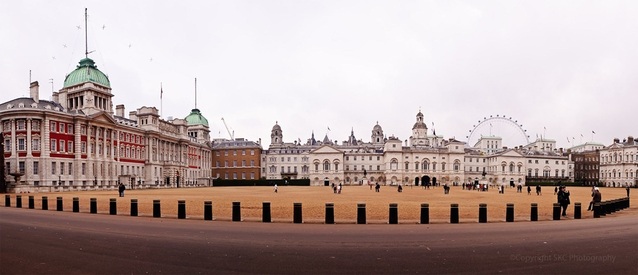 Horse Guards Parade, London In the next series of this essay (Part Two in a series), the Regiments that are on Parade for both the Beating Retreat and Trooping the Colour will be explored, as will the event of Trooping the Colour, the Queen’s Birthday Parade itself.
This year the event marked the 85th birthday of the Sovereign who has reigned over the country since 1952.
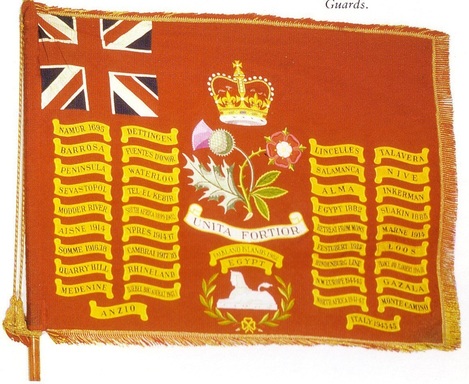 The Colour being paraded on Horse Guards this year was the flag of the 1st Battalion Scots Guards. In the past colours, or flags, were carried, or "trooped", down the ranks so that it could be seen and recognised by the soldiers as they were used as rallying points in the confusion of fighting. In the 18th century, guards from the Royal palaces assembled daily on Horse Guards to 'troop the colours', and in 1748 it was announced that the parade would also mark the Sovereign's official birthday.
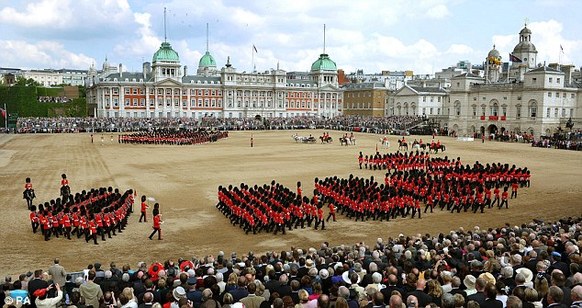 Trooping the Colour originated from traditional preparations for battle. 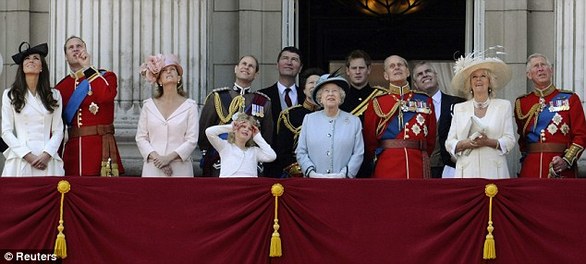 The Duke and Duchess of Cambridge played prominent roles in this year's ceremony for first time. 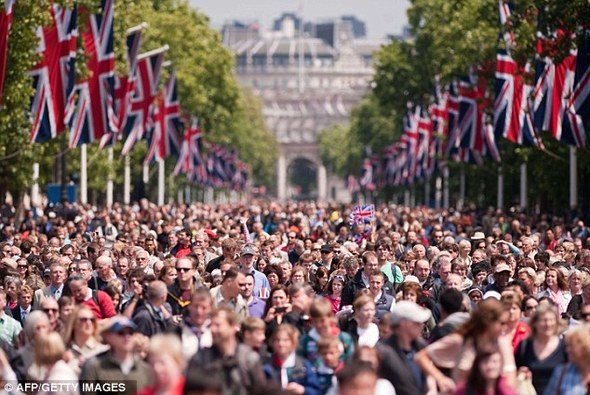 Thousands of well wishers turned out to celebrate The Queen's official birthday.
The Duke turns ninety today and in honour of this very special occasion Her Majesty The Queen has conferred the title and office of Lord High Admiral to His Royal Highness. The British Monarchist League would like to wish the longest serving Royal consort in British history many more happy and healthy years.
By:
Scott Pepé.
Youth Co-ordinator, The British Monarchist League
A month on from the Royal Wedding, the Youth Co-Ordinator reflects on that magical day in April.
“Blimey”, I said to my good friend Callum, the train’s empty, as we boarded the half past two to London on Thursday afternoon. ‘That’s because we’ll be the first up there’ he replied! It didn’t take long for conversation to start on the train. The 3 union Jacks we had each – one as a cloak, the other two on sticks. Along with the deckchairs, tents and the gastronomic picnic rather gave away our intentions. “Going up to the wedding” most people asked. A lovely lady expressed her wish to join us but said she was having a street party instead. We must of spoken to 50 people on the hour long journey up, and whilst we got different 50 excuses of why our offer to join us for the camp out was turned down, we only got one response to the question “ but you are going to watch it right?’: “Of Course”
As we got off at Waterloo, one thing became clear. We were not the first people there! It was half 3 in the afternoon and as we passed Westminster Abbey the crowd was already 10 deep. Fortunately, that’s not where we wanted to camp! It was in front of Buckingham Palace for us! London looked amazing, like a girl on her prom night. Donned in red white and blue everywhere. Even the eye had been made up for the event. The short walk to The Mall took us at least an hour. Everyone just wanted to talk to everyone else about the wedding, the Queen and how beautiful our city looked. Whitehall was spectacular! Every lamppost with the ceremonial union flag hanging from it, and then the bunting across the top. ‘This is what Britain should look like’, I thought. We spent a lot of our walk taking pictures on behalf of tourists, but there was plenty of time of pictures of our own in front of the household cavalry and a particular stereotypical policeman. I am convinced that they picked the policeman on the basis of how stereotypical they were, everyone seemed to have the ‘ello, ello, ello’ voice! I made sure I wouldn’t be scrumpin’ any apples that night. In all seriousness , the Met did an outstanding job at the wedding and I cannot thank them enough. A moments thought at the Cenotaph and we were at the Admiralty building. What a sight she was. Lit up, with Union Jacks exploding from every angle and beyond her The Mall, looking exactly as it should. In the distance: Buckingham Palace with royal standard. It then sunk in… we were at the royal wedding.
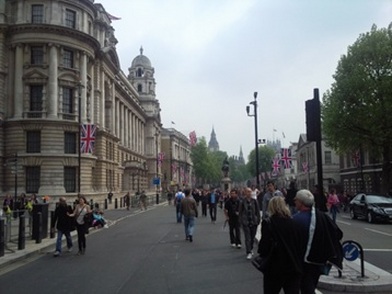 Wonderful Whitehall We cut through Green park and managed to get a spot right in front of the palace. It was PACKED! We were next to a brilliant Filipino chap who had been here since Monday, Vernon and Mildred – a quintessentially British couple, some Irish guards (off duty) and naturally, some Americans. It was delightfully international and yet so British. A first snippet of the unity that the Monarchy brings.
Picnics and great conversation is what I shall remember that night for. We learned how a Canadian couple had brought their tickets the moment they had heard about the engagement. We met Simon Watkinson, who you may know from the T-Mobile ad. Staying stubbornly In character, he informed us that he was feeling a bit nervous about tomorrow. As the flasks of tea went down, and the consumption of scotch eggs went up, conversation moved on to why we are here, and why we are monarchists. We are well rehearsed in the arguments for monarchism. You can imagine what came up. ‘We don’t get to celebrate Britishness enough, this is our one opportunity” was a big one. The Americans said that lots of people in America remain fascinated by an institution they no longer have. The Americans have an enormous respect for tradition, heritage and national celebration. But being a nation for less than 250 years a lot of it seems artificial: July 4th and the constant worshiping of the star spangled banner she noted as examples. The British monarchy does not have an artificial feel at all. It seems like it’s been there for a very long time. That’s just how I like it. When my grandmother showed me pictures of when her and my grandfather went to the wedding of Princess Elizabeth and Philip I had long dreamt of attending such an occasion. Now I was there, and it all looked exactly how it should have done. It was strange to think that I was sitting where my mother and father had for the wedding of Charles and Diana, and where my grandparents had done before. Once again, it optimised the continuity and tradition that we all love about the British Monarchy.
We tried to sleep but it was hopeless. Everyone was too excited and I had to be up in a few hours for an Interview. By the time 6’o clock came round it was time to trudge through to the media centre. Again, the scale was astonishing. News teams from everywhere. The Americans occupied the most space (The CNN tent was astonishing – f1 motorhome style). There were also teams from Africa, Asia and South America. I was given my pass and taken up to Nicky Campbell who undoubtedly had the best view in town – from the top of big green building many of you will have seen on the television. I was on after a brilliant American (James I think) who had set up a website for Americans who loved Britain. He was almost as excited as me. Suddenly I was on air, only then did it sink in that I was talking to Nicky Campbell, who speaks from my radio most days and my television every Sunday morning. Tired and star struck I feel I gave a mediocre interview but fortunately the feedback was very positive. After the LBC one though, I was disappointed. Back to the tent and to wake Callum up (he got his standard 6 hours). The time was 7 o’clock… four hours to go!
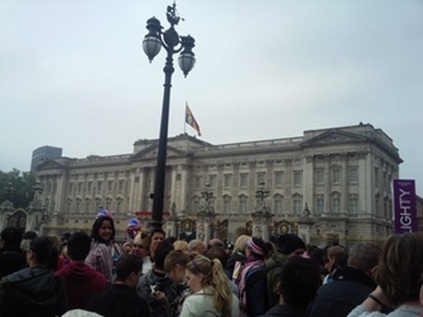 View from our tent For those who say the Monarchy does not represent Britain, I wish I could invite them to the four hours leading up to the wedding. The Buckingham palace speakers poured out Jerusalem, Land of Hope and Glory, Rule Britannia etc. How the crowd responded. I lead the singing from Callum’s shoulders - to rapturous applause…. Who knows if they were clapping my singing, or the fact I had stopped. The front of Buckingham Place was really filling up and by 8 ‘o clock they had closed the entrance to Buckingham from Green Park. It was also beginning to get really noisy in anticipation. The television channel Blighty was handing out free periscopes, so we could all see what was going on. At 9:00 the red cover for the Balcony was on and by 10:00 Buckingham palace was beginning to wake up. We sensed movement.
I will never forget the moment I first saw Her Majesty Elizabeth II in person. I was sitting on Callum’s shoulders and before I noticed she was coming I had 50 cameras shoved at me demanding I took a photo. The roar was incredible. These were not people who wanted a republic! These were people who were truly grateful for HM’s service to our county, and didn’t she look fantastic. If the arrival of the Queen was signalled by the mass accumulation of cameras, then the arrival of Catherine Middleton to The Mall was signalled by noise. It was incredible! She looked absolutely stunning and she seemed so attentive to crowd. I’m glad she went to the mall before the wedding, to properly thank the people who had camped out to see her at least!
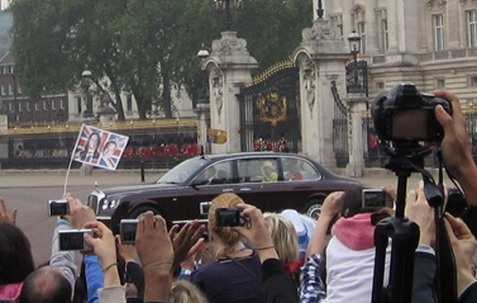 The first time I saw HM The Queen. Note her waving at me! Despite the lack of TV screens outside the palace, the wedding itself was still a lovely occasion. It was dead silent when the ceremony was happening, but erupted into voice during the hymns and of course when they were officially married.
When they got back the crowd were hysterical! It was the first time we had seen Prince William because he had left from Clarence House further down. It was amazing to be so close to the people that anything up to 2billion could be watching. I adored the pomp and circumstance. The carriages, the cavalry and the uniforms. It was all judged to perfection. It’s what we do best – always have done and always will. I was so proud that our country was pulling this off so well. It was everything we had imagined and more.
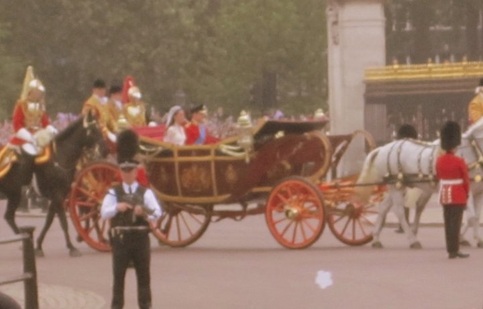 The Duke and Duchess of Cambridge return from Westminster Abbey – what a view Once The Duke and Duchess of Cambridge had disappeared into the palace, a rapid pack away operation begun. We had to be ready to sprint to the railings when the Police let the barriers down. We were ready to run at 1:15 and at about 1:20 as I seem to remember it they let us run for the railings. I can’t really remember what happened in those few minutes. I ended up with a very bruised arm and a cut on my neck. I didn’t notice until I got home - funny things excitement can do to you! After a mad rush, I managed to clasp one of the black railings. I was there. In the front row. Then, at 1:25 the moment the world had been waiting for, the moment I had been up for 31 hours for happened. Those doors were opened and the newlyweds emerged.
(covers ears)
It was amazing. I was actually there! I never thought I would hear a louder noise than when they came out…that was until they kissed! The most amazing moments were perhaps when my mind considered the situation I was in. I was at the front of an event 1 in 3 people in the world were watching. I was looking at the Queen on the balcony – something my forbears have done before me. I fell out of my daze very quickly and looked behind me. Probably the most amazing thing I have seen in my life. The Victoria monument, one million people and a Spitfire, Hurricane and the Avro Lancaster. Some old planes and the Queen on one day? Blimey.
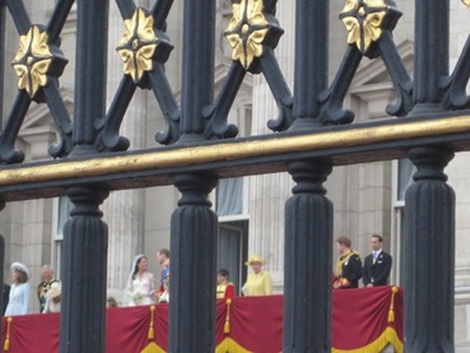 My view from the railings. Note HM The Queen catching my eye AGAIN! The fly past was absolutely fantastic too! Have a look at my video here: http://www.facebook.com/video/video.php?v=2020084388829. It was such an apt finish to what was a truly amazing day that I was very privileged to experience. It was not quite the end of course: the walk back to Waterloo took 2 hours in sweltering heat! I was shattered and then, the first train home was completely full. Did it ruin my day? Impossible! I was buzzing! Next train home, shower, bed and I put the royal wedding on! Watching the Royal Wedding on TV afterwards was lovely, but nothing in comparison to being there. Being able to see the service was a major plus for you guys I’ll admit! I loved the bit where Katherine smiled as the crowd roared from outside. I also thought that William saluting the cenotaph and Catherine bowing her head was extremely moving. ‘Bloody hell Scott’ you’re thinking. I was expecting a huge discussion on how the Royal Wedding showed the monarchy to be constitutionally right for this country. I was expecting all the politics to come out. You’ve just given me a blow by blow account of your day – ‘fantastic’. That is true and I’m hugely apologetic to those who found this immensely boring! But I think you don’t need any more justification than this as to why the Monarchy must stay. A head of state is not the government; a head of state is the symbolic head of the nation. If the Royal Wedding was not the most symbolic, celebrated event of my lifetime then I would ask what is. One million people do not attend the weddings of Presidents, for a president does not represent the tradition, history and circumstance of a country. Our Royal family provides the British with a well-earned opportunity to celebrate our britishness. Hence the fly past, hence the patriotic music. It was so refreshing to see everyone unashamed to wave their union jack with pride. When Royals have a state occasion, it actually means something. President Blair trooping the colour? No thanks. The Royal Wedding was a comprehensive endorsement of British Monarchism. For every one person that attended the republican street party there were over 5 entire street parties. For every one person that went to their bitter shindig one thousand went to the mall. More turned up to Wills and Kate than they did to Charles and Diana. I notice that Republic moved on from the wedding very quickly. That’s because in their eyes, it was a very big failure. I should thank the Met again they were grand, Kate, Vernon, Mildred and everyone else I spent the night with. And of course Callum, whose shoulders were exhausted! It really was one of the best days of my life. Why? Not just because I saw the Queen and the Kiss. But because everything I believed in, the monarchy, the British people and the pomp and circumstance of our country had gone out there today and played a blinder. The polls that said 79% of people weren’t interested were blown out of the window, the rumours that there would be hoards of trouble makers were ousted and fears (hoes if you’re a republican) that we would all drown turned out to be unfounded. We used to rule the waves, but our influence has slowly declined. On April 29th however, for once, the world was interested in Britain again. Dozing off on the train home, I was so proud to have been there, so proud to be a monarchist. 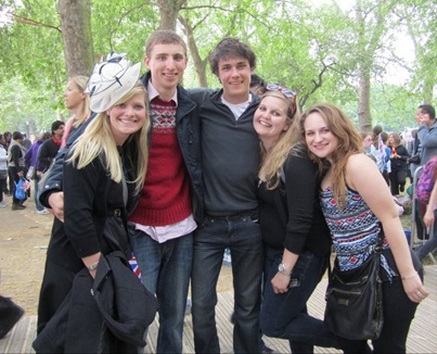 Myself (left) and Callum (Right) with the Americans)
On this day in 1953, Elizabeth II was crowned Queen of the United Kingdom.
The British Monarchist League cannot ignore this fact and so in the run up to the referendum on Scottish independence we will be promoting and defending the union.
The Queen has expressed concerns in the past over the potential break up of the United Kingdom.
In the year of the Silver Jubilee(1977), Her Majesty said:
"I cannot forget that I was crowned Queen of the United Kingdom of Great Britain and Northern Ireland. Perhaps this Jubilee is a time to remind ourselves of the benefits which union has conferred, at home and in our international dealings, on the inhabitants of all parts of this United Kingdom."
Our motto is 'For Crown and Country'; we believe that a divided UK would significantly weaken the monarchy. Therefore it is the duty of the British Monarchist League to take a pro-union stance on this issue.
By:
Matthew Hone
Member, The British Monarchist League The affection for Her Majesty Queen Elizabeth II around the world can only be produced by a hereditary and constitutional system.
Yesterday President Obama of the United States began his state visit to the UK, a symbol of the bond between the two countries. He and his wife Michelle stay as guests of the Queen at Buckingham Palace, and they are known to have a close relationship with both Her Majesty and His Royal Highness the Duke of Edinburgh.
“I think what the Queen symbolises not just to Great Britain, but to the entire Commonwealth, and obviously the entire world, is the best of England”, Obama said in an interview last week with the BBC's Andrew Marr. While the reference to England is unfortunate (the Royal Family take care to keep their links to Scotland and Wales strong), it is still high praise indeed, because this is exactly what the Queen should do.
The role of any country's head of state is to symbolise the nation. Once they fail to do that, they lose their legitimacy. This year Elizabeth II beat her ancestor George III to the title of second longest reigning British monarch. Next year will be her Diamond Jubilee. In her 59 years on the throne, she has seen drastic changes in society. Governments, Prime Ministers and indeed empires have come and gone, but she has remained throughout a loyal servant to her people. On multiple occasions she has defied the predictions of republicans that the monarchy was an antique soon to be consigned to the annals of history. But her Golden Jubilee in 2002 saw millions celebrate in the streets of London, and this year's wedding of Prince William and Catherine Middleton had a worldwide audience of at least 300 million, 25 million of whom were in the UK. There has never been more evidence that the monarchy connects with the general public.
I believe this sense of history and stability could not come about through an elected system. Political heads of state come and go, often using their office for self-serving purposes and ultimately losing their legitimacy in the eyes of the people. One only needs to look at the approval ratings of the last President of the United States at the end of his tenure, or the embarrassing spectacle of the Italian President being hauled through his country's courts, to see the dangers of switching our time-proved system.
Of course, an accountable democracy must have its party political system. But for the idea of the country itself to have any meaning, there must also be tradition and continuity. These symbols are embodied to the people of the world in one person. The office of constitutional monarchy is uniquely suited to this task.
By:
Joe Eldren
Member, The British Monarchist League The Republic Campaign (the actual author is anonymous) recently posted a comment on the Royal Collection. You can read the article here. A quick read of this might leave you a little unsettled – so many artefacts poorly catalogued and suffering from poor conservation because of a lack of money; only a privileged few get to see the Collection; and any criticism means you get struck off the list of people the Collection will lend to, so Republic says. Doesn't sound very good, does it? Perhaps, you think, there is a case for transferring ownership to the government who will care for the items 'properly'. Well, let's deconstruct the article and see what our author - who dare not speak his name - is actually saying (and we'll be correcting a few rather glaring errors on the way, gentle reader, so bear with me!) Statements by Republic Campaign are in italicised blue; those by the Royal Collection and others are emboldened. “The Royal Collection is a vast collection of art assembled by monarchs over the last 500 years. It includes around 150,000 paintings by artists such as Rubens, Rembrandt, Mantegna, Titian and Raphael. The Collection's total value has been estimated at £10 billion.” Well for a start there aren't 150,000 paintings! The Collection confirmed in an email to me that they hold only around 10,000 paintings (including miniatures). There are of course a considerable number of other items – furniture, ceramics, clocks, silver, sculpture, jewellery, books, manuscripts, prints and maps, arms and armour, fans, and textiles. The valuation Republic gives appears to be a straight lift from an undated Wikipedia entry rather than anything based on a professional view; this also seems based on an estimate by an individual who didn't actually see the Collection! “The bulk of the Royal Collection was assembled by Charles I and dispersed throughout the country at the time of the Commonwealth. During the Restoration, Charles II was able to reassemble the majority of the collection, although a number of pieces were sold to European museums such as the Prado in Spain.” Once again a rather large error here. The Royal Collection's website clearly says “The Collection has largely been formed since the Restoration of the Monarchy in 1660. Some items belonging to earlier monarchs, for example Henry VIII, also survive. The greater part of the magnificent collection inherited and added to by Charles I was dispersed on Cromwell's orders during the Interregnum. The royal patrons now chiefly associated with notable additions to the Collection are Frederick, Prince of Wales; George III; George IV; Queen Victoria and Prince Albert; and Queen Mary, consort of George V.” 'Dispersed' means of course seized and sold off – Cromwell and the Puritans were the cultural philistines of their day. It is rather dismaying to read the same short-sighted postings by Republic's supporters, arguing that a national and cultural treasure should be sold off for short-term financial gain; clearly there is a lack of investment in our cultural heritage. As Harold Macmillan once noted, it's akin to selling off the family silver. Republic campaign places a link to the Royal Collection's website; such a shame they didn't seem to follow it themselves. “The Royal Collection is "held in trust by the Queen as Sovereign for her successors and the nation, and is not owned by her as a private individual". In other words, it is owned by us - the people of Britain. It is unclear whether the royal family fully understand what this means, however; until relatively recently the Royal Collection website claimed that it was the private collection of the Queen.” Dear oh dear, where to start with this? To paraphrase: “It is not owned by the Queen as a private individual, therefore it is owned by 'us'”. Oh, really? Did ' us' pay for it? No, ' us' did not – the money was spent by the Monarch from a combination of own resources and money voted by the state for the upkeep of the Royal Household. Republicans will of course immediately argue that as taxpayers they are the source of funding and so 'ownership' ultimately resides with them. First off this is factually incorrect – the acquiring monarch may well (and often did) use private funds. Secondly, to argue that ownership belongs with the original source of the funding is quite fatuous. As an example, imagine that your employer comes to you one day and says, 'Hey, that house, that car, that nice stereo – they all belong to me, because I paid your wages!” Clearly absolute nonsense. Once the money has been handed over it is up to the recipient how they spend or invest it. That the monarch spends private money to enhance the Collection for the benefit of the nation as a whole is something to be celebrated, not condemned through ignorance or plain mischief. “It is unclear whether the royal family fully understand what this means” - which is of course a generalised statement with absolutely no meaning or relevance, but designed to throw a little mud and see if it sticks in the reader's mind. I could as easily write 'It is unclear whether the republican campaign fully understand what this means' in relation to ownership. I'll give another example of their playing with words later in this piece. “Around 3,000 objects in the collection are on permanent loan to museums. Other pieces are on display in former royal residences such as Hampton Court.”
The rest of the Collection is stored away from public view and is notoriously difficult to access, even for academics and art historians. The only people with regular and unfettered access to the Collection are the royal family and their employees.”No collections, whether public or private, save for a very few small ones, place their entire stock on public display. Allowing people 'unfettered' access to this or any other collection is simply not something that happens for goodness' sake – to do so would mean one would very shortly not have a collection at all! Securing a collection is standard practise and it is rather nonsensical – but rather typical - to point a finger at the Royal Collection for adhering to such.“The maintenance and care of the Royal Collection is the responsibility of the Royal Collection Trust (established in 1993 and chaired by Prince Charles).”Well, they got that right at least!“As a charity, the trust receives no government subsidy and maintains the collection using only the income generated by visitors.” And this is wrong how exactly? It is an essentially private collection made over in trust to the nation, it costs the taxpayer nothing at all. Again, something to be celebrated, not denigrated when government is looking to cut costs. “This means that we are denied a stake in our national art collection and, unlike the works housed in the National Gallery, we have no way of ensuring proper standards of conservation and cataloguing are maintained.”It is NOT a 'national'' art collection, nor is it 'ours' however much Republic would like it to be misrepresented as such. Details of conservations are routinely published in the Annual Reports of the Collection, available online here. The past 5 years for example have seen literally hundreds paintings fully or partially conserved. Many items of course have already either been conserved in the past or do not require actual conservation in any case. At this point I'll enter a quote from the London based Social Affairs Unit: Finally, a word about the catalogue. There are plenty of ways in which other British art collections might be well-advised to emulate the Royal Collection. There's the high morale of the staff, for instance, who from the security guard on the door to the coat-room lady to the Surveyor himself, come across as unfailingly welcoming, helpful and keen to make every visit a success - or the exhibition spaces, which from the formal entrance area to the galleries to the baby-changing room, for heaven's sake, are well-designed, functional and aesthetically pleasing - or even the shows themselves, which, as with last year's excellent George III exhibition, somehow work both as crowd-pleasers and as serious curatorial events. Indeed, while sour-faced republicans periodically make noises about delivering this collection 'back to the people' (presumably with as much success as Cromwell or the Paris mob, this being republicanism's track-record in action) it would be far easier to frame an argument as to why more public collections should be offered to Her Majesty, if she could promise they would all be run as efficiently, effectively and as selflessly as her own Collection has been. “Like the royal properties, the Royal Collection appears to be suffering due to lack of funds. Curators and art historians are concerned about the impact the Trust's lack of money is having on conservation. Few are prepared to speak out openly, however, for fear that the Trust will refuse to lend items to other museums and galleries.”Of course, no actual evidence is produced to support this. Academics are notorious for complaining when historical items they have an interest in are in some way at risk – yet none can be found to make any sort of public statement. Academics abroad are even freer to make some comment; again, none can be found. One academic might hesitate to criticise; but a group of them? Hardly. This sort of approach is very typical of the Republic Campaign and akin to ringing a doorbell and running away – the poor householder is left puzzled at the intrusion, whilst the mischievous urchin stands sniggering around the corner watching the disruption he's caused. Following on from my point above about spurious statements, I could also just as easily write here that “some republicans are concerned that, over the last few years since their campaign took on a full-time official, their standing in opinion polls measuring support for a republican form of government has fallen (which is true by the way). No-one appears able to speak out against this damaging trend” (which is also true, but an opinion rather than a verifiable fact). Placing the two together gives a much more damaging interpretation, a cynical ploy the spokesman for Republic Campaign is rather over-fond of using and which of course his followers swallow hook line and sinker. “There is disturbing evidence that the Collection is at risk due to the stubbornness of the royals. It appears that, as with the royal properties, there is fierce resistance to bringing the collection under full public ownership - and to the greater public access this would entail.”So, what is the 'disturbing evidence'? As we have already seen, there is NOT ONE shred of it. As for “... resistance to bringing the collection under full public ownership...” (aka compulsory nationalisation) this is otherwise known as resisting an outrageous attempt to recategorise one's private goods and chattels as belonging to the 'state' - or ' us' as Republic would have it. Note also that compensation has not once been mentioned – reminiscent of Cromwell's approach and which should leave you shuddering with fear as to what would actually happen to YOUR wealth and your planned inheritance to your children should they ever get their republican way – which, fortunately, is a VERY long way off.
|

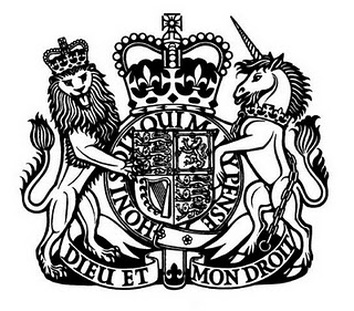





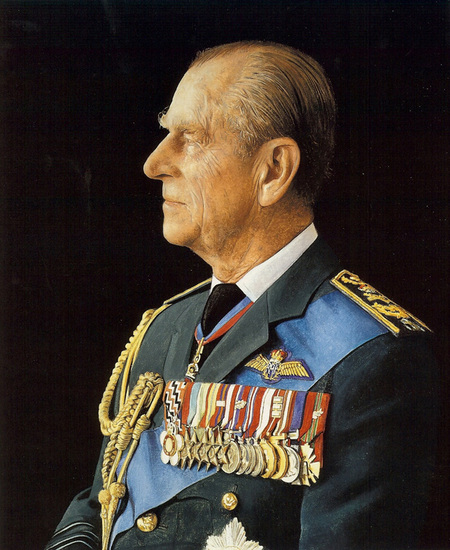






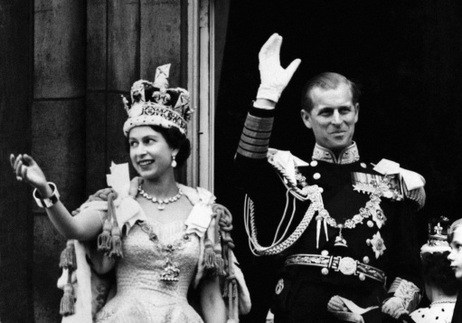
 RSS Feed
RSS Feed